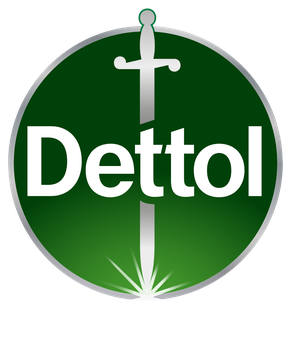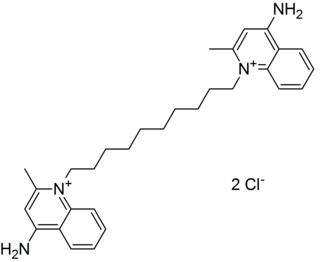A bactericide or bacteriocide, sometimes abbreviated Bcidal, is a substance which kills bacteria. Bactericides are disinfectants, antiseptics, or antibiotics. However, material surfaces can also have bactericidal properties based solely on their physical surface structure, as for example biomaterials like insect wings.

Chlorine is a chemical element with the symbol Cl and atomic number 17. The second-lightest of the halogens, it appears between fluorine and bromine in the periodic table and its properties are mostly intermediate between them. Chlorine is a yellow-green gas at room temperature. It is an extremely reactive element and a strong oxidising agent: among the elements, it has the highest electron affinity and the third-highest electronegativity on the revised Pauling scale, behind only oxygen and fluorine.
An antiseptic is an antimicrobial substance or compound that is applied to living tissue to reduce the possibility of sepsis, infection or putrefaction. Antiseptics are generally distinguished from antibiotics by the latter's ability to safely destroy bacteria within the body, and from disinfectants, which destroy microorganisms found on non-living objects.

Sodium hypochlorite, commonly known in a dilute solution as (chlorine) bleach, is an inorganic chemical compound with the formula NaOCl, consisting of a sodium cation and a hypochlorite anion. It may also be viewed as the sodium salt of hypochlorous acid. The anhydrous compound is unstable and may decompose explosively. It can be crystallized as a pentahydrate NaOCl·5H
2O, a pale greenish-yellow solid which is not explosive and is stable if kept refrigerated.

A disinfectant is a chemical substance or compound used to inactivate or destroy microorganisms on inert surfaces. Disinfection does not necessarily kill all microorganisms, especially resistant bacterial spores; it is less effective than sterilization, which is an extreme physical or chemical process that kills all types of life. Disinfectants are generally distinguished from other antimicrobial agents such as antibiotics, which destroy microorganisms within the body, and antiseptics, which destroy microorganisms on living tissue. Disinfectants are also different from biocides—the latter are intended to destroy all forms of life, not just microorganisms. Disinfectants work by destroying the cell wall of microbes or interfering with their metabolism. It is also a form of decontamination, and can be defined as the process whereby physical or chemical methods are used to reduce the amount of pathogenic microorganisms on a surface.

Benzalkonium chloride, also known as alkyldimethylbenzylammonium chloride (ADBAC) and by the trade name Zephiran, is a type of cationic surfactant. It is an organic salt classified as a quaternary ammonium compound. ADBACs have three main categories of use: as a biocide, a cationic surfactant, and a phase transfer agent. ADBACs are a mixture of alkylbenzyldimethylammonium chlorides, in which the alkyl group has various even-numbered alkyl chain lengths.

Zinc chloride is the name of inorganic chemical compounds with the formula ZnCl2. It forms hydrates. Zinc chloride, anhydrous and its hydrates are colorless or white crystalline solids, and are highly soluble in water. Five hydrates of zinc chloride are known, as well as four forms of anhydrous zinc chloride. This salt is hygroscopic and even deliquescent. Zinc chloride finds wide application in textile processing, metallurgical fluxes, and chemical synthesis. No mineral with this chemical composition is known aside from the very rare mineral simonkolleite, Zn5(OH)8Cl2·H2O.

In organic chemistry, quaternary ammonium cations, also known as quats, are positively-charged polyatomic ions of the structure [NR4]+, where R is an alkyl group, an aryl group or organyl group. Unlike the ammonium ion and the primary, secondary, or tertiary ammonium cations, the quaternary ammonium cations are permanently charged, independent of the pH of their solution. Quaternary ammonium salts or quaternary ammonium compounds are salts of quaternary ammonium cations. Polyquats are a variety of engineered polymer forms which provide multiple quat molecules within a larger molecule.

Dettol is a cleaning disinfectant and antiseptic. It was introduced in 1932 by the British company Reckitt. In Germany, it is sold under the name Sagrotan.

Behentrimonium chloride, also known as docosyltrimethylammonium chloride or BTAC-228, is a yellow waxlike organic compound with chemical formula CH3(CH2)21N(Cl)(CH3)3, used as an antistatic agent and, sometimes, a disinfectant. It is commonly found in cosmetics such as conditioners, hair dye, and mousse, and also in detergents. Laboratory tests have indicated that it does not readily biodegrade.

A permanganate is a chemical compound with the manganate(VII) ion, MnO−
4, the conjugate base of permanganic acid. Because the manganese atom has a +7 oxidation state, the permanganate(VII) ion is a strong oxidising agent. The ion is a transition metal ion with a tetrahedral structure. Permanganate solutions are purple in colour and are stable in neutral or slightly alkaline media. The exact chemical reaction depends on the carbon-containing reactants present and the oxidant used. For example, trichloroethane (C2H3Cl3) is oxidised by permanganate ions to form carbon dioxide (CO2), manganese dioxide (MnO2), hydrogen ions (H+), and chloride ions (Cl−).

Bromine monochloride, also called bromine(I) chloride, bromochloride, and bromine chloride, is an interhalogen inorganic compound with chemical formula BrCl. It is a very reactive golden yellow gas with boiling point 5 °C and melting point −66 °C. Its CAS number is 13863-41-7, and its EINECS number is 237-601-4. It is a strong oxidizing agent. Its molecular structure in the gas phase was determined by microwave spectroscopy; the Br-Cl bond has a length of re = 2.1360376(18) Å. Its crystal structure was determined by single crystal X-ray diffraction; the bond length in the solid state is 2.179(2) Å and the shortest intermolecular interaction is r(Cl···Br) = 3.145(2) Å.

Benzethonium chloride, also known as hyamine is a synthetic quaternary ammonium salt. This compound is an odorless white solid, soluble in water. It has surfactant, antiseptic, and anti-infective properties, and it is used as a topical antimicrobial agent in first aid antiseptics. It is also found in cosmetics and toiletries such as soap, mouthwashes, anti-itch ointments, and antibacterial moist towelettes. Benzethonium chloride is also used in the food industry as a hard surface disinfectant.

Lysol is a brand of American cleaning and disinfecting products distributed by Reckitt, which markets the similar Dettol or Sagrotan in other markets. The line includes liquid solutions for hard and soft surfaces, air treatment, and hand washing. The active ingredient in many Lysol products is benzalkonium chloride, but the active ingredient in the Lysol "Power and Free" line is hydrogen peroxide. Lysol has been used since its invention in the late 19th century as a household and industrial cleaning agent, and previously as a medical disinfectant.

Mercuric amidochloride is an inorganic compound with the formula Hg(NH2)Cl.
Didecyldimethylammonium chloride (DDAC) is a quaternary ammonium compound used as antiseptic/disinfectant. It causes the disruption of intermolecular interactions and the dissociation of lipid bilayers. The bacteriostatic or bactericide activity of DDAC depends on its concentration and the growth phase of the microbial population. It is a broad spectrum biocidal against bacteria and fungi and can be used as disinfectant cleaner for linen, recommended for use in hospitals, hotels and industries. It is also used in gynaecology, surgery, ophthalmology, pediatrics, OT, and for the sterilization of surgical instruments, endoscopes and surface disinfection.

Dequalinium is a quaternary ammonium cation and bolaamphiphile commonly available as the dichloride salt. It is useful as an antiseptic and disinfectant. The bromide, iodide, acetate, and undecenoate salts are known as well. Dequalinium chloride is the active ingredient of several medications.
A virucide is any physical or chemical agent that deactivates or destroys viruses. The substances are not only virucidal but can be also bactericidal, fungicidal, sporicidal or tuberculocidal.
Potassium hypochlorite is the potassium salt of hypochlorous acid. It is used in variable concentrations, often diluted in water solution. It has a light grey color and a strong chlorine smell. It can be used as a disinfectant.
Dimethyloctadecyl(3-trimethoxysilylpropyl)ammonium chloride (DTSACl) is a disinfectant used as a preservative and fungicide. Its chemical formula is C26H58NO3SiCl. It is also used as a silane coupling agent.














